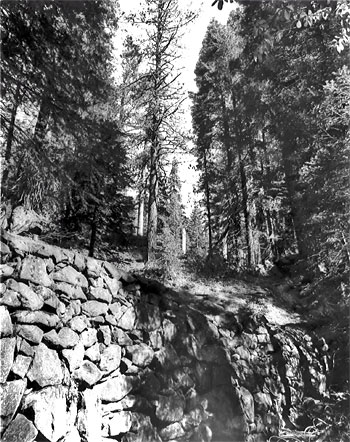National Register of Historic Places in Tuolumne County
Great Sierra Wagon Road
AKA Aspen Valley Road
Yosemite National Park
Built 1882
The Great Sierra Wagon Road was constructed in 1882 by the Great Sierra Silver Mining to transport supplies to their mine on the summit of Tioga Hill. The construction was unusually permanent for a mountain road with stone abutted bridges and retaining walls built whenever the least necessity dictated.
Chinese laborers were used to a large extent and paid the impressive sum of $1.20 a day; Caucasians received $1.50, the foreman $2.00 per day. According to one report, there were 90 whites and 250 Chinese; another alludes to 160 Chinese out of 250 laborers.
In any event, the road, reaching a total length of 56¼ miles, was completed'in 130 days for a total cost of $61,095.22 - about $1100 per mile.
The road had barely reached completion when the Great Sierra Mine proved a losing venture and was abandoned. Use of the wagon road stopped except for a few intrepid travelers.
The road remained in a state of neglect for over 30 years, while still in private hands. The Government could not meet the price being asked, although the Army began agitating to acquire the route shortly after the establishment of the national park. The importance of the road was recognized for some time, not only as a means of establishing a new route across the Sierra Nevada and opening up the northern part of the Yosemite region, but, with the advent of the automobile, it was seen as a link in transcontinental travel.
In 1915 the road was acquired by the National Park Service and deeded over to the Government. That same year, the "highway" was opened to motor car travel.
In 1937 the section of road from the western boundary to White Wolf Lodge was realigned, bypassing Aspen Valley for a two-lane paved road via Crane Flat, on the Big Oak Flat Road. Except for the section leading to the private homes in Aspen Valley, this section of the original Great Sierra Wagon Road remains relatively unchanged from its earliest days.
Excerpted from the NRHP nomination dated 12 September 1977.
